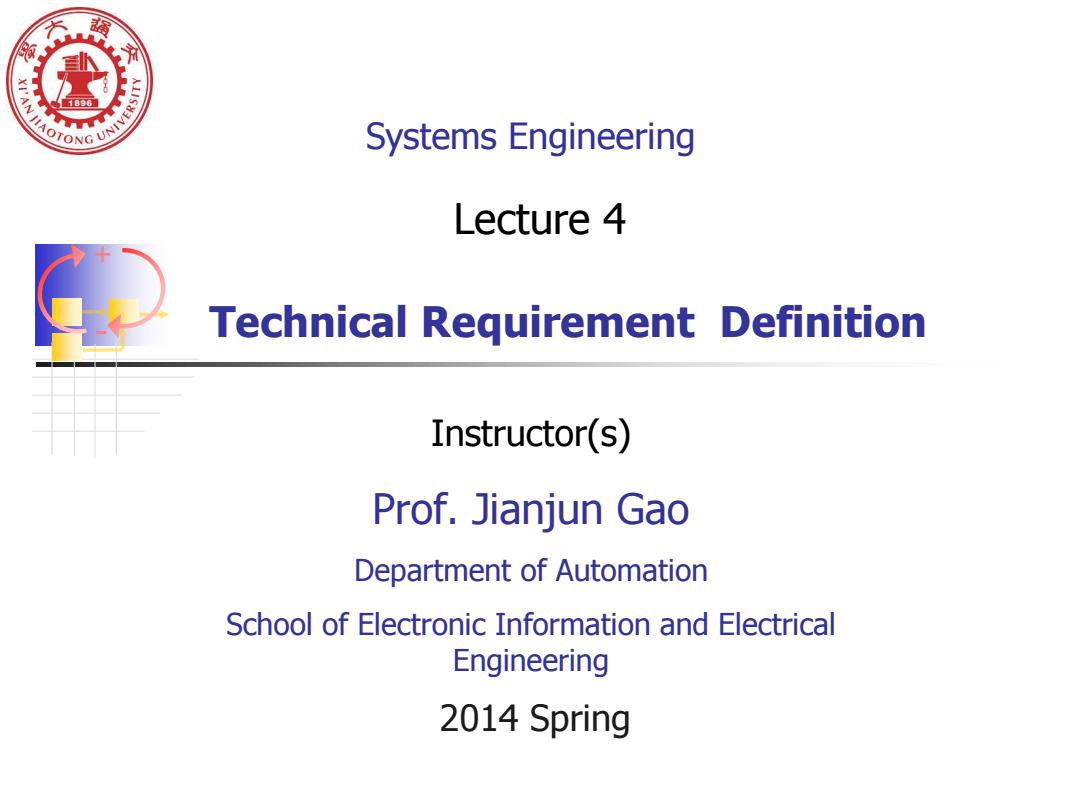
JIAOTONG UNIVERSITY 096 Systems Engineering Lecture 4 Technical Requirement Definition Instructor(s) Prof.Jianjun Gao Department of Automation School of Electronic Information and Electrical Engineering 2014 Spring
Systems Engineering Instructor(s) + - 2014 Spring Technical Requirement Definition Prof. Jianjun Gao Department of Automation School of Electronic Information and Electrical Engineering Lecture 4
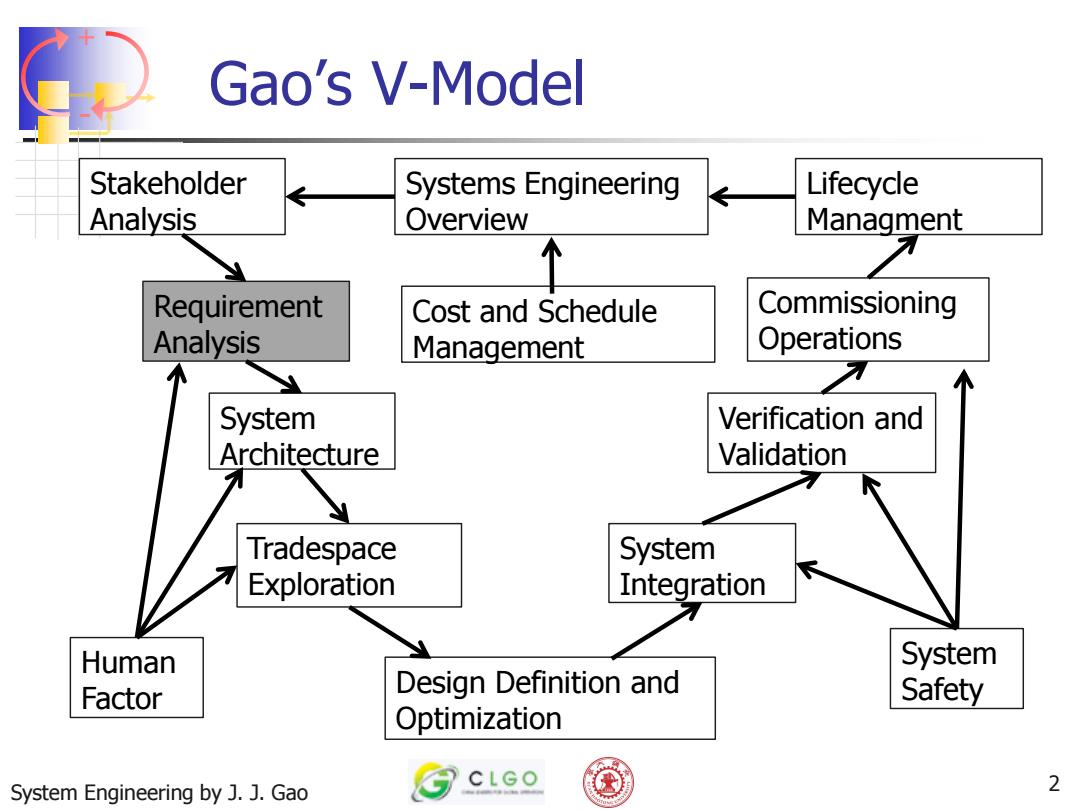
Gao's V-Model Stakeholder Systems Engineering Lifecycle Analysis Overview Managment Requirement Cost and Schedule Commissioning Analysis Management Operations System Verification and Architecture Validation Tradespace System Exploration Integration Human System Factor Design Definition and Safety Optimization CLGO System Engineering by J.J.Gao 2
+ - System Engineering by J. J. Gao 2 Gao’s V-Model Stakeholder Analysis Requirement Analysis System Architecture Tradespace Exploration Design Definition and Optimization System Integration Verification and Validation Commissioning Operations Lifecycle Managment Systems Engineering Overview Cost and Schedule Management Human Factor System Safety
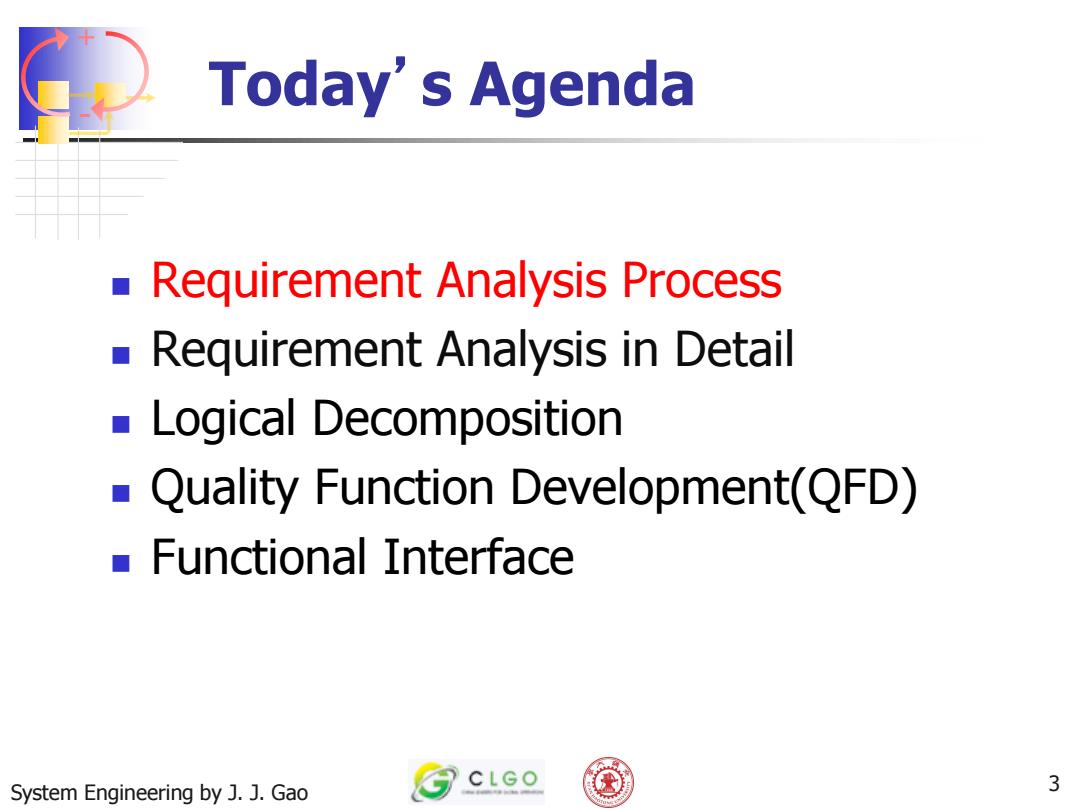
Today's Agenda Requirement Analysis Process Requirement Analysis in Detail Logical Decomposition Quality Function Development(QFD) Functional Interface CLGO System Engineering by J.J.Gao 3
+ - 3 Today’s Agenda Requirement Analysis Process Requirement Analysis in Detail Logical Decomposition Quality Function Development(QFD) Functional Interface System Engineering by J. J. Gao
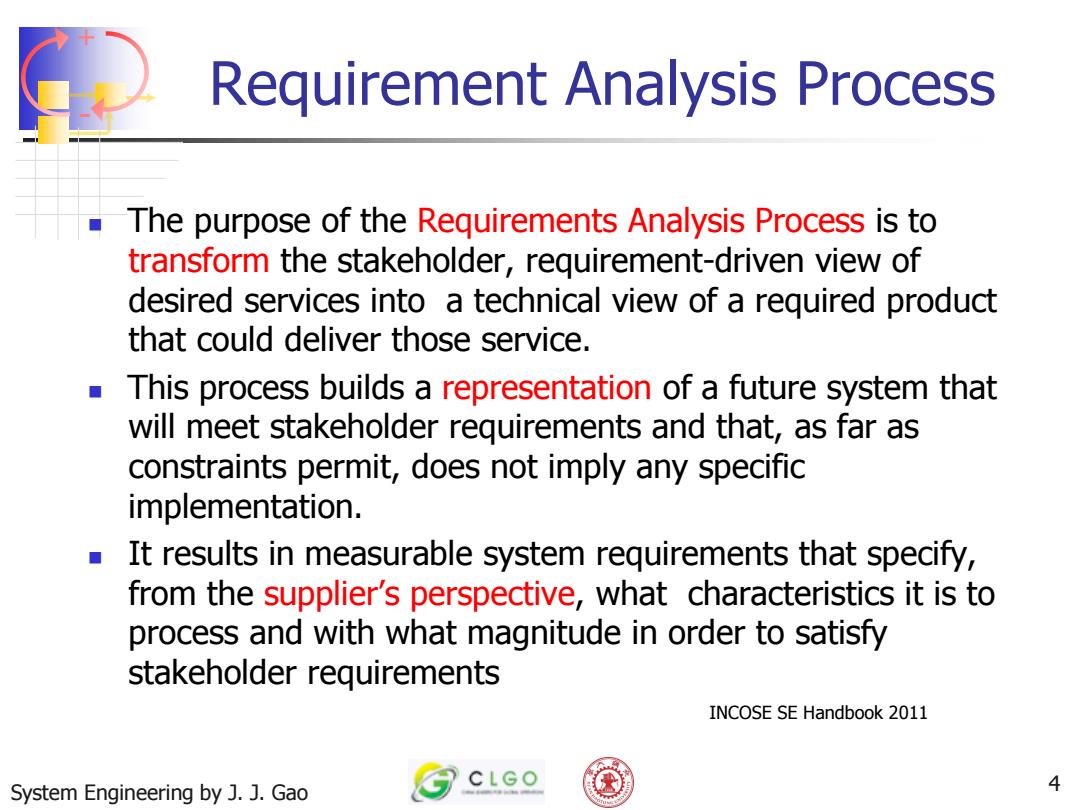
Requirement Analysis Process The purpose of the Requirements Analysis Process is to transform the stakeholder,requirement-driven view of desired services into a technical view of a required product that could deliver those service. This process builds a representation of a future system that will meet stakeholder requirements and that,as far as constraints permit,does not imply any specific implementation. It results in measurable system requirements that specify, from the supplier's perspective,what characteristics it is to process and with what magnitude in order to satisfy stakeholder requirements INCOSE SE Handbook 2011 CLGO System Engineering by J.J.Gao 4
+ - The purpose of the Requirements Analysis Process is to transform the stakeholder, requirement-driven view of desired services into a technical view of a required product that could deliver those service. This process builds a representation of a future system that will meet stakeholder requirements and that, as far as constraints permit, does not imply any specific implementation. It results in measurable system requirements that specify, from the supplier’s perspective, what characteristics it is to process and with what magnitude in order to satisfy stakeholder requirements System Engineering by J. J. Gao 4 Requirement Analysis Process INCOSE SE Handbook 2011
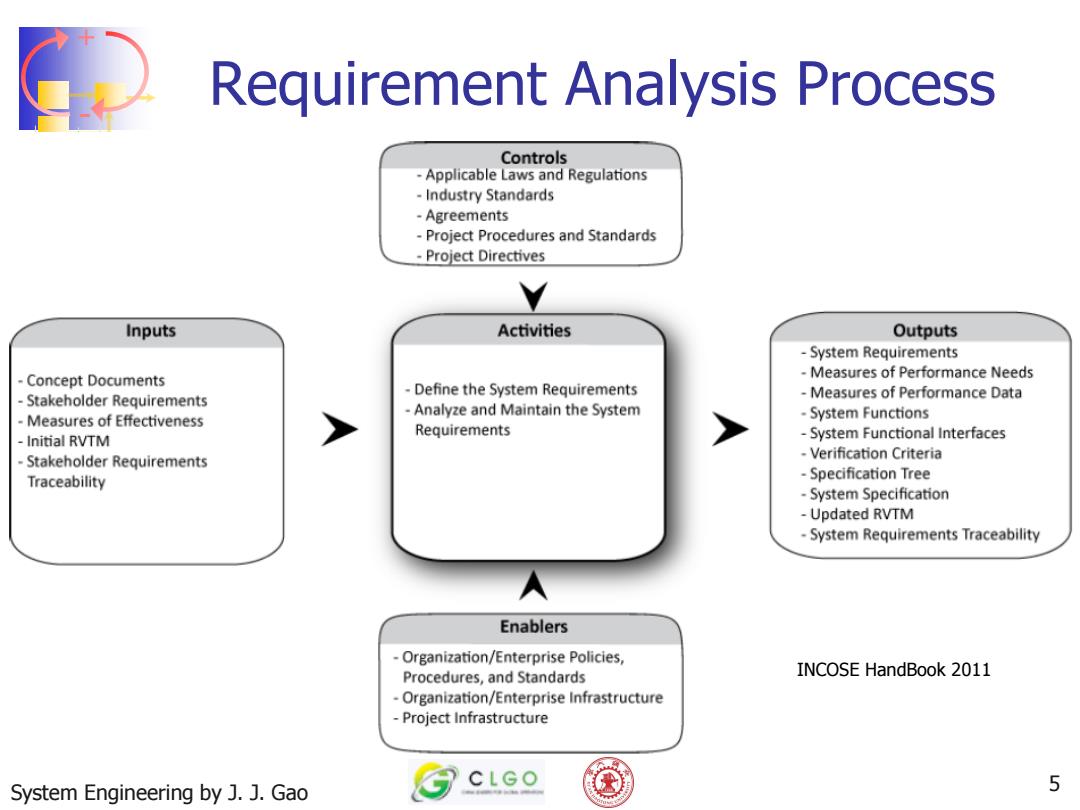
Requirement Analysis Process Controls Applicable Laws and Regulations Industry Standards -Agreements Project Procedures and Standards Project Directives Inputs Activities Outputs -System Requirements Concept Documents Measures of Performance Needs Define the System Requirements Stakeholder Requirements -Measures of Performance Data Measures of Effectiveness Analyze and Maintain the System System Functions Requirements Initial RVTM -System Functional Interfaces Stakeholder Requirements Verification Criteria Traceability -Specification Tree System Specification -Updated RVTM System Requirements Traceability Enablers -Organization/Enterprise Policies, Procedures,and Standards INCOSE HandBook 2011 Organization/Enterprise Infrastructure -Project Infrastructure CLGO System Engineering by J.J.Gao 5
+ - System Engineering by J. J. Gao 5 Requirement Analysis Process INCOSE HandBook 2011

Analyze scope of problem From Stakeholder Expectations Definition Define design and Define functional and To Logical Decomposition and Configuration and Requirements Management Processes product constraints behavioral expectation in Management and Interface technical terms Baselined Stakeholder Management Processes Expectations Validated Technical Define performance Requirements requirements for each Baselined Concept of defined functional and Operations behavioral expectation To Logical Decomposition and Technical Data Management Processes Baselined Enabling Support Strategies Measures of Define technical require- Performance ments in acceptable From Stakeholder "shall"statements Expectations Definition To Technical and Technical Data Assessment Process Management Processes Technical Performance Measures of Validate technical Define measures of Measures Effectiveness requirements performance for each measure of effectiveness NASA SE HandBook Establish technical Define technical requirements baseline performance measures Figure 4.2-1 Technical Requirements Definition Process CLGO System Engineering by J.J.Gao 6
+ - System Engineering by J. J. Gao 6 NASA SE HandBook
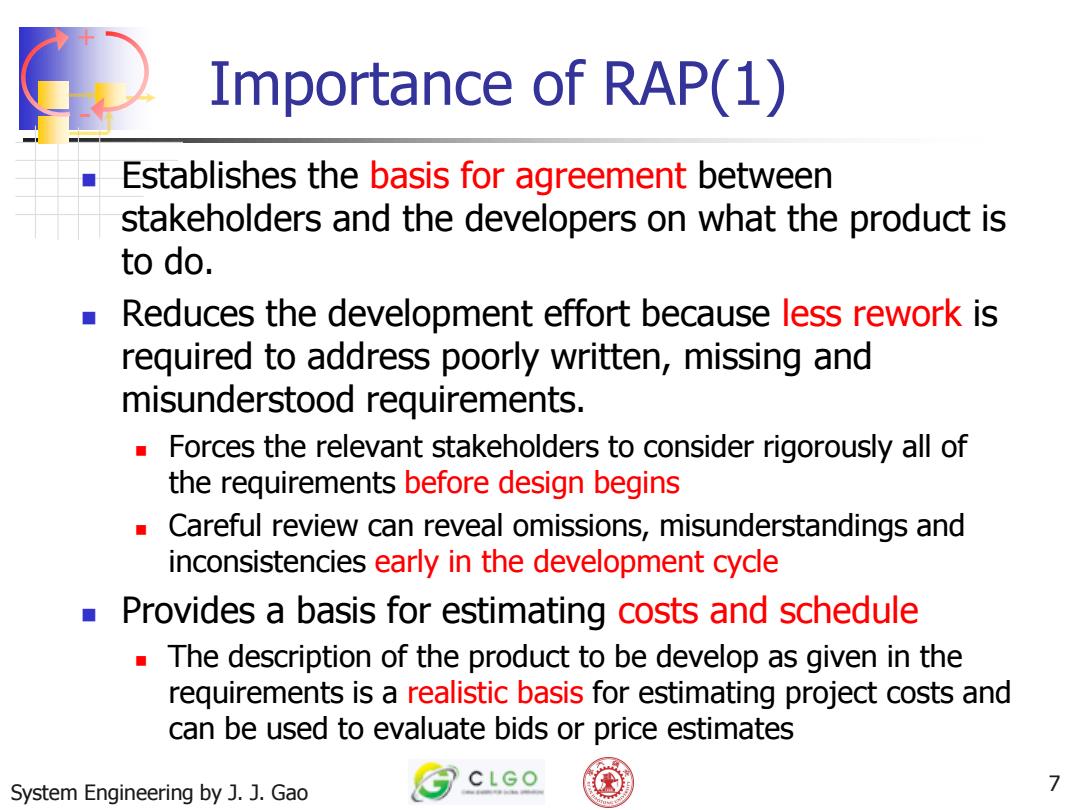
Importance of RAP(1) Establishes the basis for agreement between stakeholders and the developers on what the product is to do. ■ Reduces the development effort because less rework is required to address poorly written,missing and misunderstood requirements. Forces the relevant stakeholders to consider rigorously all of the requirements before design begins Careful review can reveal omissions,misunderstandings and inconsistencies early in the development cycle Provides a basis for estimating costs and schedule The description of the product to be develop as given in the requirements is a realistic basis for estimating project costs and can be used to evaluate bids or price estimates System Engineering by J.J.Gao CLGO 7
+ - Establishes the basis for agreement between stakeholders and the developers on what the product is to do. Reduces the development effort because less rework is required to address poorly written, missing and misunderstood requirements. Forces the relevant stakeholders to consider rigorously all of the requirements before design begins Careful review can reveal omissions, misunderstandings and inconsistencies early in the development cycle Provides a basis for estimating costs and schedule The description of the product to be develop as given in the requirements is a realistic basis for estimating project costs and can be used to evaluate bids or price estimates System Engineering by J. J. Gao 7 Importance of RAP(1)
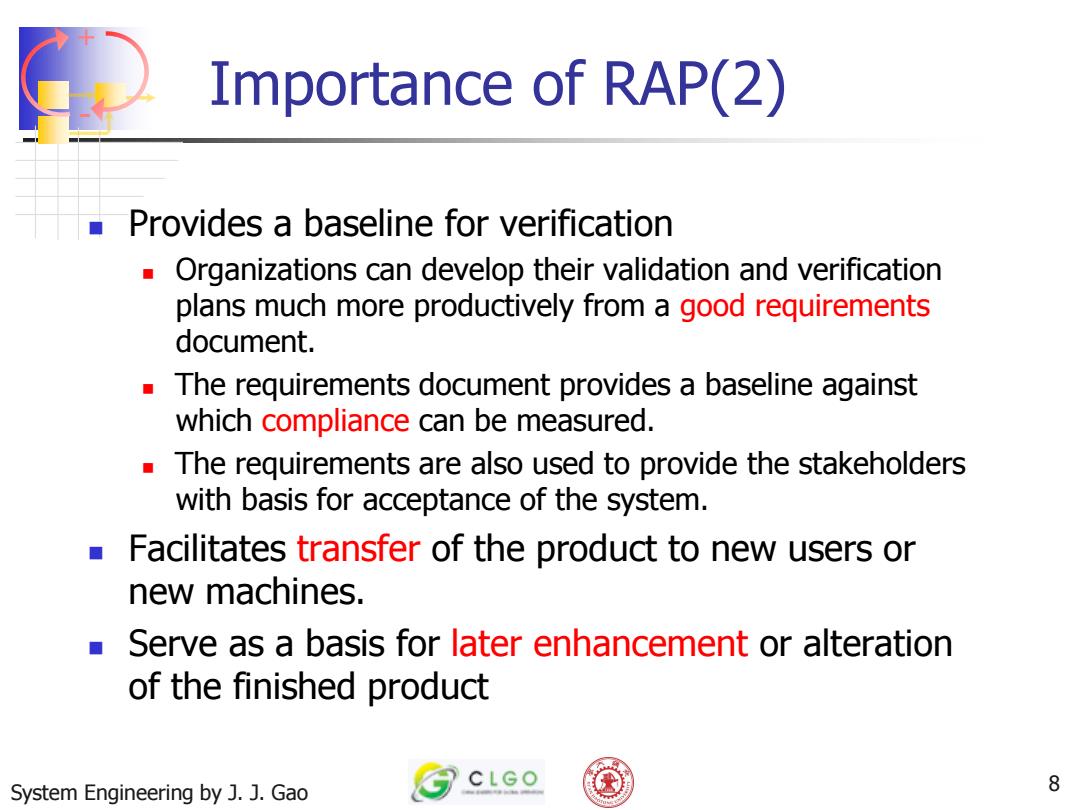
Importance of RAP(2) Provides a baseline for verification Organizations can develop their validation and verification plans much more productively from a good requirements document. The requirements document provides a baseline against which compliance can be measured. The requirements are also used to provide the stakeholders with basis for acceptance of the system. Facilitates transfer of the product to new users or new machines. Serve as a basis for later enhancement or alteration of the finished product CLGO System Engineering by J.J.Gao 8
+ - Provides a baseline for verification Organizations can develop their validation and verification plans much more productively from a good requirements document. The requirements document provides a baseline against which compliance can be measured. The requirements are also used to provide the stakeholders with basis for acceptance of the system. Facilitates transfer of the product to new users or new machines. Serve as a basis for later enhancement or alteration of the finished product System Engineering by J. J. Gao 8 Importance of RAP(2)
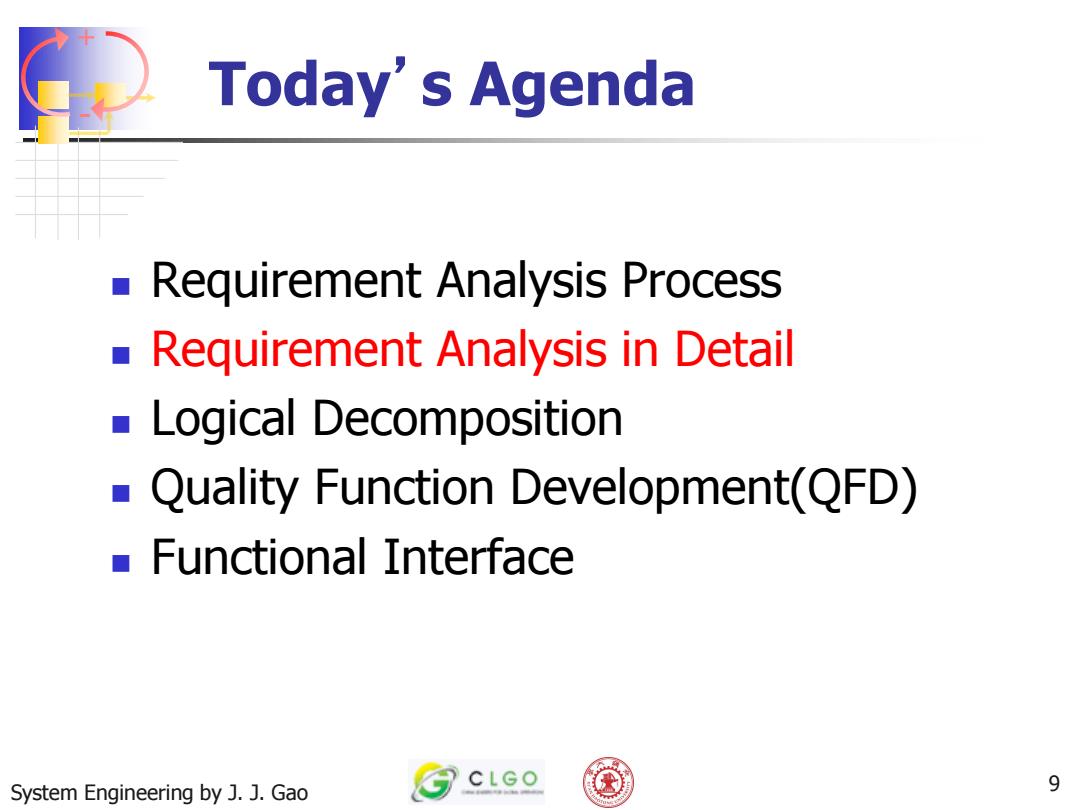
Today's Agenda Requirement Analysis Process Requirement Analysis in Detail Logical Decomposition Quality Function Development(QFD) Functional Interface CLGO System Engineering by J.J.Gao 9
+ - 9 Today’s Agenda Requirement Analysis Process Requirement Analysis in Detail Logical Decomposition Quality Function Development(QFD) Functional Interface System Engineering by J. J. Gao
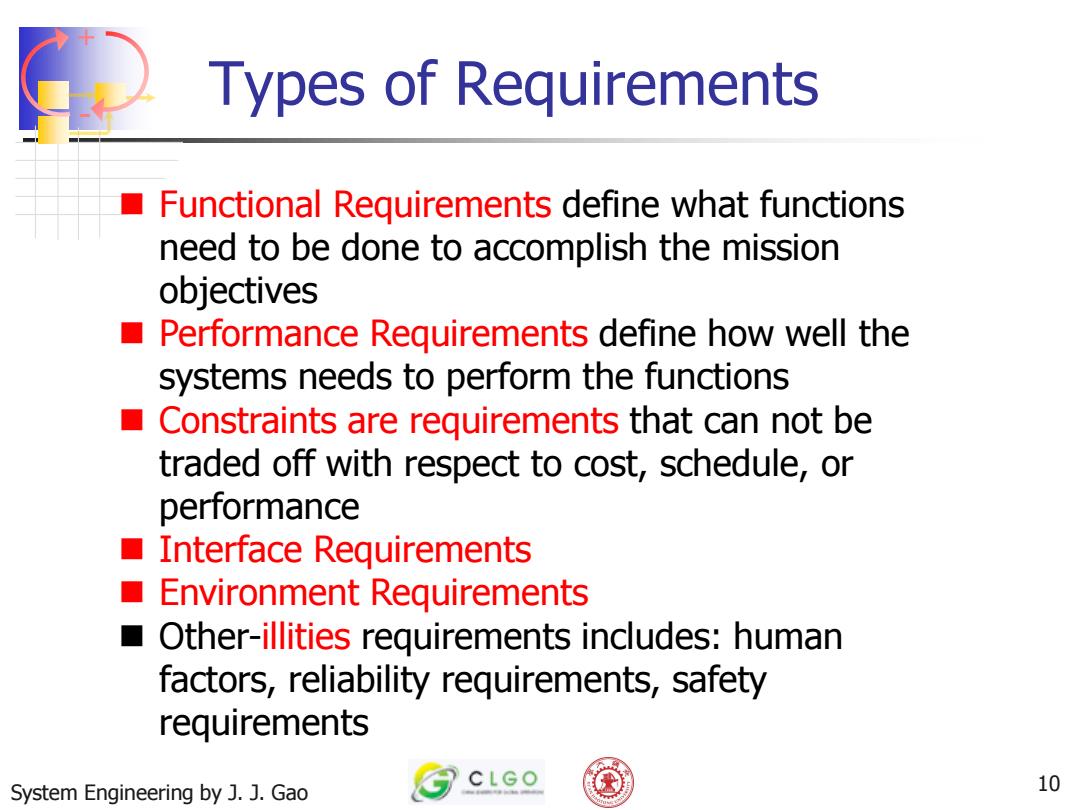
Types of Requirements Functional Requirements define what functions need to be done to accomplish the mission objectives ■ Performance Requirements define how well the systems needs to perform the functions ■ Constraints are requirements that can not be traded off with respect to cost,schedule,or performance Interface Requirements Environment Requirements ■ Other-illities requirements includes:human factors,reliability requirements,safety requirements CLGO System Engineering by J.J.Gao 10
+ - System Engineering by J. J. Gao 10 Types of Requirements Functional Requirements define what functions need to be done to accomplish the mission objectives Performance Requirements define how well the systems needs to perform the functions Constraints are requirements that can not be traded off with respect to cost, schedule, or performance Interface Requirements Environment Requirements Other-illities requirements includes: human factors, reliability requirements, safety requirements